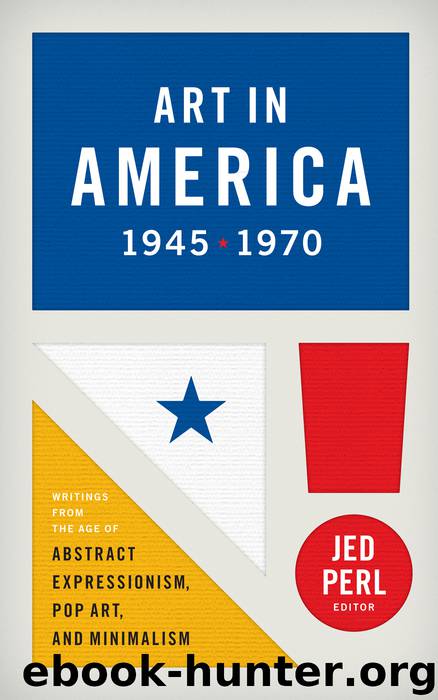Art in America 1945-1970 by Jed Perl

Author:Jed Perl [Perl, Jed]
Language: eng
Format: epub
ISBN: 9781598533675
Publisher: Library of America
Published: 2014-07-10T17:19:00+00:00
1957
On the Humanity of Abstract Painting
THE notion of humanity in art rests on a norm of the human that has changed in the course of time. Not long ago only the heroic, the mythical and religious were admitted to high art. The dignity of a work was measured in part by the rank of its theme.
In time it became clear that a scene of common life, a landscape or still life could be as great a painting as an image of history or myth. One discovered too that in the picturing of the non-human were some profound values. I do not mean only the beauty created by the painter’s control of color and shapes; the landscape and still life also embodied an individual’s feeling for nature and things, his vision in the broadest sense. Humanity in art is therefore not confined to the image of man. Man shows himself too in his relation to the surroundings, in his artifacts, and in the expressive character of all the signs and marks he produces. These may be noble or ignoble, playful or tragic, passionate or serene. Or they may be sensed as unnameable yet compelling moods.
At the threshold of our century stands the art of Cézanne, which imposes on us the conviction that in rendering the simplest objects, bare of ideal meanings, a series of colored patches can be a summit of perfection showing the concentrated qualities and powers of a great mind. Whoever in dismay before the strangeness of certain contemporary works denies to the original painting of our time a sufficient significance and longs for an art with noble and easily-read figures and gestures, should return to Cézanne and ask what in the appeal of his weighty art depends on a represented human drama. Some of his portraits, perhaps—although to many observers, accustomed to the affability of old portraiture, Cézanne’s appeared only a few decades ago mask-like and inhuman, a forerunner of the supposed loss of humanity in twentieth-century art. But are those portraits of Cézanne greater for us, more moving, even more dramatic, than his pictures of fruit and rumpled cloth?
The humanity of art lies in the artist and not simply in what he represents, although this object may be the congenial occasion for the fullest play of his art. It is the painter’s constructive activity, his power of impressing a work with feeling and the qualities of thought that gives humanity to art; and this humanity may be realized with an unlimited range of themes or elements of form.
All this has been said often enough; it is granted, and still one clings to Cézanne’s apple and doubts in principle that high accomplishment in art is possible where the imagination of colors and forms is divorced from the imaging of the visible world.
Architecture, which represents nothing, is a permanent challenge to that theoretical belief. If a building communicates the values of the home or temple, it is through the splendor of its freely invented forms. However bound to materials and functions, these forms are an expression, not a representation, of the familial or sacred.
Download
This site does not store any files on its server. We only index and link to content provided by other sites. Please contact the content providers to delete copyright contents if any and email us, we'll remove relevant links or contents immediately.
| Coloring Books for Grown-Ups | Humor |
| Movies | Performing Arts |
| Pop Culture | Puzzles & Games |
| Radio | Sheet Music & Scores |
| Television | Trivia & Fun Facts |
Make Comics Like the Pros by Greg Pak(2746)
The Social Psychology of Inequality by Unknown(2745)
Stacked Decks by The Rotenberg Collection(2672)
Purple Hibiscus by Chimamanda Ngozi Adichie(2442)
The Queen of Nothing by Holly Black(2281)
The Art of Doom by Bethesda(2034)
Putin's Labyrinth(1886)
The Power of Habit: Why We Do What We Do in Life and Business by Charles Duhigg(1868)
Life of Elizabeth I by Alison Weir(1861)
Things Are What You Make of Them: Life Advice for Creatives by Adam J. Kurtz(1746)
Drawing Down the Moon by Margot Adler(1715)
Agency by William Gibson(1715)
Wall and Piece by Banksy(1708)
The Beatles Lyrics by Hunter Davies(1590)
Only What's Necessary: Charles M. Schulz and the Art of Peanuts by Chip Kidd(1584)
Art Of Atari by Tim Lapetino(1557)
Teaching to Transgress: Education as the Practice of Freedom (Harvest in Translation) by Bell Hooks(1544)
The Andy Warhol Diaries by Andy Warhol(1497)
Pop Manga by Camilla D'Errico(1472)
